
By Jim Dunning
(This article was originally published in “Irelands Own” magazine. The webmaster would like to gratefully thank the author for his kind permission in reprinting it here.)
When a body is described as being incorrupt it means that it does not decay after death. The same cannot be said of a body that is well preserved or mummified, or has undergone an embalming process. Most such corpses become stiff, but incorruptible saints remain completely flexible, as if they are only sleeping.
This is particularly true of Saint Bernadette [pictured above] whose body is displayed in a glass case at the Convent of Nevers in France. In spite of having died more than 130 years ago, she looks for all the world as if she is about to wake up. It is true that when she was exhumed a second time, the nuns gave her face a light wax mask, but this was done mainly to cover damage caused earlier by washing. A doctor who removed one of her ribs to provide a relic found her body had remained pliable. Pope John XXIII’s body remains intact, but it was embalmed for his lying in state and the Church does not claim that it is incorruptible due to supernatural reasons.
There is a whole list of saints, however, whose bodies have been found to be incorrupt. Not all of them were Roman Catholics. The Russian Orthodox Church is well represented by such as St. Alexander of Svir, who was a monk, and by the martyrs of Vilnius, St. Anthony, St. John and St. Eustathios.
The exhumation of saints’ bodies may appear a macabre business, but the first examples of incorruptibility were discovered by accident. It usually happened when a body was being transferred from one place to another. Now, of course, the Church is more alive to the possibility. Not that it expects the body of every saint to be incorruptible. Indeed, it is unusual, and no one knows why a few saints’ bodies are preserved and most are not. Some believe that the piety of a particular saint is so remarkable that it permeates the whole body, while others believe that decomposition has been prevented directly by God, irrespective of the degree of piety.
The argument for a physical cause, usually applied to persons not known for their religious background, relates to the physical environment in which decomposition has been retarded by the cool, dry conditions of the place of burial. With regard to Catholic saints, the Church maintains that the environments in which saints’ bodies have been preserved are normal, or even, in some instances, particularly damp. Sometimes two bodies will be buried side by side, as was the case with Jacinta Marto and her brother Francisco, the young seers of Fatima, yet only one was preserved.
Cases of incorruptibility go back a long way. The first saint whose body was found to be incorrupt was St. Cecilia, who was martyred in AD 177. Her remains were moved to a new site in 822, and in 1599 an exhumation revealed her body to be incorrupt. Over the centuries more than 100 cases of saints whose bodies have remained incorruptible have come to light, sometimes, as with St. Cecilia, many years after their death.
St. Agnes of Montepulciano died in 1317. Not only did her body remain incorrupt, but a perfumed liquid flowed from her hands and feet. She was canonized by Pope Benedict XIII in 1726. Another Italian, St. Catherine of Bologna, died at the age of 49 in the year 1463 and was canonized in 1712. She was buried unembalmed and without a casket; 18 days later, after various reports of graveside miracles, her body was exhumed and found to be flexible and uncorrupted. It was moved to the chapel of the Poor Clares in Bologna where it is displayed to this day, dressed and seated upright in a glass case.
 St. Catherine Labouré (1806 – 1876) [pictured to the left] was born in Burgundy, France. She is famous for having passed on a request from Our Lady for the creation of the Miraculous Medal, worn now by thousands of the faithful. When her body was exhumed in 1933 it was found to be incorrupt. It rests now on display in the chapel of Our Lady of the Sun in the Rue du Bac, Paris.
St. Catherine Labouré (1806 – 1876) [pictured to the left] was born in Burgundy, France. She is famous for having passed on a request from Our Lady for the creation of the Miraculous Medal, worn now by thousands of the faithful. When her body was exhumed in 1933 it was found to be incorrupt. It rests now on display in the chapel of Our Lady of the Sun in the Rue du Bac, Paris.
In October, 1977, the canonization took place of an ordained Lebanese Maronite Catholic monk named Charbel Makhlouf. He had lived as a hermit from 1875 until his death at the age of seventy in 1898. With a reputation for holiness, he followed a strict fast and was devoted to the Blessed Sacrament. After his death, mysterious, dazzling lights were seen over his grave and pilgrims began to visit. His corpse which had been exuding sweat and blood was transferred to a special coffin, and hordes of pilgrims swarmed to the place seeking his intercession. They still do.
As recently as January, 1993, a partially paralysed fifty-six-year old woman named Nohed El Shami saw two Maronite monks standing next to her bed. They performed surgery on her neck and when she woke up she found two wounds on her neck. She was completely healed and able to walk again. One of the monks she identified as Charbel. His canonization took place on 9th October, 1977, in the Vatican.
 [Pictured to the left is the popular Saint John Vianney, affectionately known as the Cure d’Ars] Mention has been made of the exudation of sweat and blood from St. Charbel’s body. The same symptoms have been observed with other saints, often many years after their death. The odour of sanctity is frequently mentioned, not only at the time of death or burial, but many years later. It is frequently described as a sweet-smelling perfume. In the case of the Venerable Mother Maria of Jesus (a contemporary of St. Theresa of Avila), who died in 1640, the odour detected on the occasion of her exhumation in 1929 was described as a ‘sweet perfume of roses and jasmines’ which clung not only to her body, but to articles she was known to have used during her lifetime. This was 289 years after her death!
[Pictured to the left is the popular Saint John Vianney, affectionately known as the Cure d’Ars] Mention has been made of the exudation of sweat and blood from St. Charbel’s body. The same symptoms have been observed with other saints, often many years after their death. The odour of sanctity is frequently mentioned, not only at the time of death or burial, but many years later. It is frequently described as a sweet-smelling perfume. In the case of the Venerable Mother Maria of Jesus (a contemporary of St. Theresa of Avila), who died in 1640, the odour detected on the occasion of her exhumation in 1929 was described as a ‘sweet perfume of roses and jasmines’ which clung not only to her body, but to articles she was known to have used during her lifetime. This was 289 years after her death!
The Church is reluctant to accept the incorruption of the body of a candidate for sainthood as a miracle proving sanctity. The cause of beatification is usually well under way before graves are opened for the recognition of relics. You could say that incorruption is seen as a bonus. By the same token, dissolution of a body provides no hindrance to a saint’s cause. Many of our most illustrious saints went the way of all flesh, including Saint Therese of Lisieux who foretold, correctly, that her body would not be protected.
We should gratefully accept that our ability to see the miraculously preserved bodies of individual saints is a privilege, a comfort and a source of encouragement in our daily struggle to achieve some degree of holiness.
-Click here for an excellent article on the incorrupt bodies of the Saints.










[…] http://www.fiamc.org/bioethics/incorruptibility-of-the-body/ […]
[…] http://www.fiamc.org/bioethics/incorruptibility-of-the-body/ […]
[…] http://www.fiamc.org/bioethics/incorruptibility-of-the-body/ […]